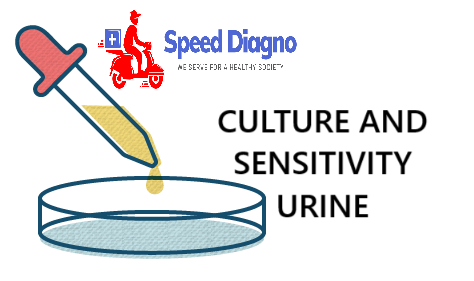- Home
-
Test Categories
- Diabetes
- Urinary
- Thyroid
- RTPCR
- Genetic
- Cancer
- Haematology
- Biochemistry
- Serology & Immunology
- Clinical Pathology
- Cytology
- Microbiology
- Endocrinology
- Histopathology
- MOLECULAR DIAGNOSTICS
- Pregnancy(Biochemistry)
- Liver
- Prostate
- Fertility
- Gastro
- Autoimmune Disorders
- Heart
- Kidney
- Vitamins
- Tuberculosis (TB)
- Anemia
- Fever
- Allergy
- Blood Tests Rare
- Profiles
- Packages
- About Us
- Why Choose Us
- Upload Prescription
- Corporate Wellness
- Contact Us

-
Overview
Urine Culture and Sensitivity is a diagnostic test used to detect and identify bacteria or fungi that cause urinary tract infections (UTIs). The test involves culturing a urine sample to grow any microorganisms present, followed by sensitivity testing to determine which antibiotics are most effective in treating the infection. This test is essential for diagnosing UTIs, guiding targeted antibiotic therapy, and preventing complications such as kidney infections.
Patient Preparation for Urine Culture and Sensitivity
Fasting Requirements:
- Fasting: No fasting is required for this test. Patients can eat and drink as usual unless specified otherwise by the healthcare provider.
Other Preparations:
- Midstream Clean-Catch Collection: The most accurate results are obtained using a clean-catch midstream urine sample. This involves specific steps to reduce contamination:
- Hydration: Patients should drink water about 30 minutes before the test to ensure an adequate urine sample.
- Hygiene: Before collecting the urine, patients should clean their genital area with water or provided wipes to reduce the presence of skin bacteria that could contaminate the sample.
- Avoid Antibiotics: If possible, the urine sample should be collected before starting any antibiotics to prevent false-negative results.
- Collection Time: Early morning samples are often preferred as they are more concentrated.
- Midstream Clean-Catch Collection: The most accurate results are obtained using a clean-catch midstream urine sample. This involves specific steps to reduce contamination:
Sample Collection Process by Speediagno Phlebotomist or Technician:
Speediagno ensures professional and sterile urine collection to provide the most accurate results for culture and sensitivity testing.
Preparation for Urine Collection:
- Identify the Patient: The technician confirms the patient’s identity using at least two identifiers (e.g., name and date of birth).
- Consent and Explanation: The procedure is explained to the patient, including the importance of proper collection techniques.
Midstream Clean-Catch Collection Process:
- Hand Hygiene and PPE: The technician performs hand hygiene and uses gloves to maintain cleanliness and prevent sample contamination.
- Provide Collection Kit: The patient is given a sterile urine collection kit, including a container and cleansing wipes.
- Patient Instructions for Collection:
- Cleaning: For women, clean the genital area from front to back using provided wipes. For men, clean the tip of the penis.
- Midstream Collection: Start urinating into the toilet, pause, and then collect the midstream portion of the urine in the sterile container. Avoid touching the inside of the container with your hands or body.
- Complete the Process: Finish urinating into the toilet. Securely close the container with the lid without contaminating the inside.
Post-Collection Care:
- Labeling and Sealing: The container is sealed tightly and labeled with the patient’s details, including the date and time of collection.
- Transport: The sample is promptly transported to the laboratory, often refrigerated if immediate testing is not possible, to maintain the integrity of the sample.
Safety and Hygiene Protocols:
- Proper Disposal: All used materials, such as wipes and gloves, are disposed of in designated waste bins.
- Documentation: The collection process and details of the sample are documented accurately to ensure proper processing and traceability.
Laboratory Processing:
- Culture: The urine sample is cultured in the laboratory to allow any bacteria or fungi to grow, usually within 24-48 hours.
- Sensitivity Testing: If microorganisms are identified, they undergo sensitivity testing to determine which antibiotics are most effective against them.
This standardized and professional approach ensures high-quality urine samples, leading to accurate diagnosis and effective treatment of urinary tract infections.
All test groups and subgroup
-
CULTURE AND SENSITIVITY URINE
-
Culture Method
-
Sample
-
Colony Count
- Culture Report:
- Antibiotic Sensitivity ( Disc Diffusion Method)
- Ampicllin
- Agumentin (Amoxicilin-Clavulanic acid)
- Piperacillin + Tazobzctum
- Cefazolin
- Cefuroxime
- Levofloxacin
- Meropenem
- Nalidixic
- Nitrofurantion
- Norfloxacin
- Tobramycin
- Amikacin
- Cefoperazone
- Cefotaxime
- Ceftazidime
- Ceftizoxime
- Ceftriaxone
- Co-trimoxazole
- Gentamycin
- Netilmycin
- Cefdinir
- Cliprofloxacin
- Azithromycin
- Linezolid
- Oxacillin
- Tetracycline
- Vancomycin
- Tiecoplanin
- Doxycycline
- Moxifloxacin
- Cefpodaxime
- Chloramphenicol
- Pipercillin
- Cefpirom
- Ampicillin and Sulbacum
- Ofloxacin
-
